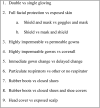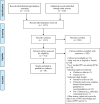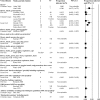Effectiveness of Personal Protective Equipment for Healthcare Workers Caring for Patients with Filovirus Disease: A Rapid Review
- PMID: 26451847
- PMCID: PMC4599797
- DOI: 10.1371/journal.pone.0140290
Effectiveness of Personal Protective Equipment for Healthcare Workers Caring for Patients with Filovirus Disease: A Rapid Review
Abstract
Background: A rapid review, guided by a protocol, was conducted to inform development of the World Health Organization's guideline on personal protective equipment in the context of the ongoing (2013-present) Western African filovirus disease outbreak, with a focus on health care workers directly caring for patients with Ebola or Marburg virus diseases.
Methods: Electronic databases and grey literature sources were searched. Eligibility criteria initially included comparative studies on Ebola and Marburg virus diseases reported in English or French, but criteria were expanded to studies on other viral hemorrhagic fevers and non-comparative designs due to the paucity of studies. After title and abstract screening (two people to exclude), full-text reports of potentially relevant articles were assessed in duplicate. Fifty-seven percent of extraction information was verified. The Grading of Recommendations Assessment, Development and Evaluation framework was used to inform the quality of evidence assessments.
Results: Thirty non-comparative studies (8 related to Ebola virus disease) were located, and 27 provided data on viral transmission. Reporting of personal protective equipment components and infection prevention and control protocols was generally poor.
Conclusions: Insufficient evidence exists to draw conclusions regarding the comparative effectiveness of various types of personal protective equipment. Additional research is urgently needed to determine optimal PPE for health care workers caring for patients with filovirus.
Conflict of interest statement
Figures






References
-
- King AMQ, Adams MJ, Carstens EB, Lefkowitz EJ. Virus Taxonomy: Classification and nomenclature of viruses. [Internet]. Available at: http://www.academia.edu/8097730/Ninth_Report_of_the_International_Commit.... Accessed from: 11-9-2015.
-
- WHO Media centre. What we know about transmission of the Ebola virus among humans. [Internet]. Available at: http://www.who.int/mediacentre/news/ebola/06-october-2014/en/. Accessed from: 4-2-2015.
Publication types
MeSH terms
Grants and funding
LinkOut - more resources
Full Text Sources
Other Literature Sources
Medical

